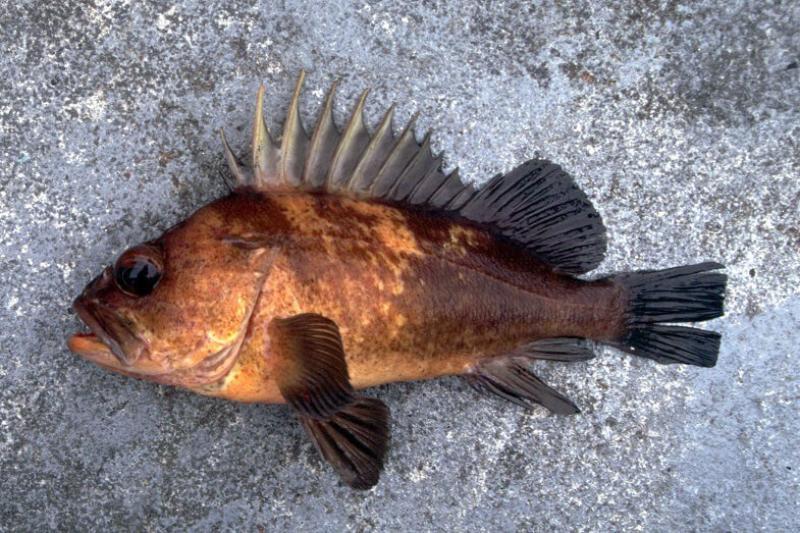
Overfished declaration for Quillback Rockfish off California likely to limit fishing
by NOAA Fisheries 22 Dec 2023 21:29 UTC

Quillback rockfish © CDFW
NOAA Fisheries today declared quillback rockfish off the coast of California overfished. This declaration prompts development of a rebuilding plan likely to curtail fishing for many species in shallow coastal waters for years.
The declaration is the result of three main factors:
- A 2021 stock assessment that considered more data on the species
- Many years of overfishing revealed by that new stock assessment
- Redefinition of West Coast quillback stocks, splitting them according to state
Where fisheries managers had long managed all quillback off the West Coast as one overall stock, research found geographic differences in their abundance and fishing pressure. In June, the Pacific Fishery Management Council, based on input from the Scientific and Statistical Committee, recommended that quillback off each of the three states be managed as separate populations. NOAA Fisheries approved the change. That makes fluctuations in any one of the smaller state-divided stocks more pronounced, with less room for declines before overfishing protections take effect.
State and federal biologists estimated the California quillback stock had declined to just 14 percent of what its natural population would be in the absence of fishing.
State and federal fisheries managers had begun to apply precautionary fishing limits for rockfish, including quillback, as early as 2021. In August 2023, the California Department of Fish and Wildlife halted all fishermen from keeping quillback rockfish to protect the species. Biologists have long asked anyone catching quillbacks to return them to their normal depths with descending devices that help the fish safely readjust to the pressure.
The Pacific Fishery Management Council will next develop a rebuilding plan. It is likely to impose greater limits on quillback and related species in the coming years. NOAA Fisheries must adopt the rebuilding plan within 2 years; it may be done as soon as early 2025.
Rockfish Have Rebounded Before
Rockfish are one of California's largest and most popular recreational and commercial fisheries. They live largely along the seafloor, taking decades to reach reproductive age and living as long as a century. California's quillback rockfish are found mainly in Northern California waters.
Rockfish have recovered from severe declines before. About 10 major species were declared overfished and in 2000 the fishery was declared a disaster. Rebuilding plans, combined with sacrifices by the fishing industry and changes in the fishery, led to the stock's recovery. In 2018, NOAA Fisheries boosted catch limits and reopened some conservation areas that had been closed to fishing.
NOAA Fisheries recently published Amendment 32 to the West Coast management plan for groundfish, which will reopen some additional areas for rockfish fishing.
Quillback rockfish are one of a group of California rockfish, which also includes China and copper rockfish, that often dwell closer to shore. Quillback rockfish had been managed collectively until 2023 when revisions to the groundfish management plan divided management up by state. That came shortly after the 2021 stock assessment indicated that quillback rockfish catches off California since the 1990s were not sustainable.
"The new information that we have now, combined with the way we are assessing and managing this stock, indicates that it has declined to the point that a rebuilding plan should be developed," said Ryan Wulff, Assistant Regional Administrator for Sustainable Fisheries in NOAA Fisheries' West Coast Region. "That is likely to cost some fishing opportunities in coming years."
He said NOAA Fisheries is working with state authorities to consider ways of collecting more data on quillback rockfish and other species to strengthen future assessments.
Opening Other Opportunities
He said that NOAA Fisheries is working with the Council and state fisheries managers to identify opportunities for increased fishing outside of nearshore waters. This would shift pressure off quillback rockfish and associated species. "We know that rebuilding will reduce some fishing opportunities and we want to look for ways to offset that."
The rebuilding plan will project how long the stock will need to rebuild. Early estimates suggest that California quillback rockfish may take between 19 and 45 years to recover to the point of sustaining fishing again. Some previously overfished West Coast groundfish, such as cowcod and Pacific ocean perch, rebounded sooner than expected. They survived better than expected during ocean conditions favorable for the species.
The Magnuson-Stevens Act that governs ocean fishing requires that rebuilding plans aim to rebuild stocks as soon as possible, so they can again sustain harvest. Rebuilding plans have proven successful with many other species. NOAA Fisheries recently announced the 50th stock to be rebuilt under a rebuilding plan since 2000.
How You Can Help Quillback Rockfish
- Use descending devices to safely return any quillback rockfish caught to their natural depth, maintaining their numbers so the stock can rebuild
- Commercial vessels should record all catches, including quillback rockfish, even if discarded; this information can help refine regulations to allow for continued fishing opportunities.
- Recreational anglers should submit their groundfish bag limits for inspection and accurately respond to surveys to provide managers with the most complete data, including whether any quillback rockfish were caught and released and if a descending device was used in their release